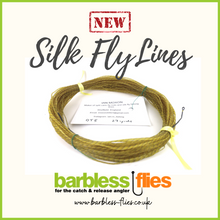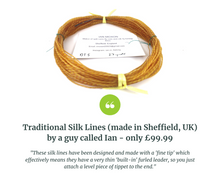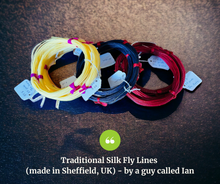A new product for us, and one we are really proud of, our
Silk Fly Lines - Made in Sheffield, UK
We decided to dip our toes into the world of specialist silk fly lines after spotting they were made in Yorkshire, so we contacted Ian Moxon (the maker) and asked if we could supply them alongside our cane rods, and he agreed - so here they are.
So, why would you use a silk line then? We're glad you asked:
- They have no memory - completely limp
- There's no stretch - improved hookups
- They are denser than plastic fly lines and therefore much thinner; and
- Thinner lines mean much less wind resistance
- They float better than plastic fly lines - they float on the water surface, not in it, making roll casts and mending line much easier
- You get 3 lines in one; When fully greased, it's a floating Line, grease everything except the tip and you have a midge-tip line, don't grease it and you have an intermediate/sinking line.
- They can last a lifetime - so long as they are cared for and stored correctly, a silk line can last a lifetime - and indeed will get better with age
*** Each of our Silk lines are shipped with a microfibre cloth (to clean/help dry them) and full line care instructions ***
These lines are made in the UK (in Sheffield, Yorkshire to be precise), by Ian Moxon.
We have created a dedicated page on our site which explains the care and use of silk fly lines, you can find it here.

Ian Moxon
"I am a Lawyer by trade and, perhaps as a consequence of the digital age, I've been more drawn towards traditional angling. Many years ago I started making my own split cane fly rods. The right line for a split cane rod is a silk fly line - the two go together wonderfully well (they feel like fly fishing should feel - amazing!). The right fly line can make a nice rod come alive - and the opposite is also true. Making my own silk fly lines has, therefore, been a natural progression from my rod making. An early inspiration for handcrafting fishing tackle was a neighbour - Stan Shaw, who was a local Cutler specialising in pen knife making.
It's my opinion that, as anglers, we are guardians of the natural riverbank environment and, as such, every effort should be made to integrate our angling enjoyment with mother nature. I've seen my local river Don transformed from a polluted ditch into a beautiful river full of wildlife, through the efforts of a small number of like-minded individuals. I feel that fishing with a plastic rod and line goes against that and is a step in the wrong direction. When we work with mother nature, rather than against her, the results are always much better. For example, bamboo (mother nature's carbon fibre) just so happens to make superb fishing rods - and silk (also an environmentally sustainable product) makes excellent fly lines.
Starting up making split cane (bamboo) rods was relatively easy because the equipment needed is relatively inexpensive and there is an abundance of information publicly available. Unfortunately, the opposite is true when it comes to making silk fly lines. It's taken me several years and many thousands of pounds of expense to get to the point where I am now.
Much of the silk that arrives in my workshop is in the form of skeins of raw reeled silk in 20/22 denier (the silk for silk fly lines is very different to silk sewing thread). Silk is available in different grades and "reeled" is the best quality!. The skeins are then washed (to remove the sericin), wound into the correct counts, braided into fly lines (tapers are created by braiding) and loose ends trimmed and burnt. The braided silk lines are then vacuum impregnated with traditional varnish (which I make myself) and finally hand polished.
A lot of my fly fishing is on the river Don system around South Yorkshire (a largely urban river system). Much of that fishing is smaller stream water and I've applied my bit of expertise in that type of fishing to the design of my lines. I've not copied anyone else's tapers.
There are only a handful of us around the world making these traditional fly lines, which is a great shame. Probably the best silk fly lines in the world are made by a guy in Japan called Koji Yano. Koji is, I suppose, my silk fly line idol and one day my lines will be up there with his. I'd urge anyone interested in buying their first silk fly line to check out Koji's website here, as his skill and exquisite lines are a true inspiration to any fly angler. Whilst I cannot, yet, promise anyone a silk line of Yano quality, I can promise a silk line that is carefully handmade, will cast well and catch fish.
There are advantages to using a silk fly line. Silk fly lines tend to be thinner than their plastic counterparts, especially in the tips, allowing better presentation of small flies. Indeed, most of my silk fly lines are so thin at the tips, no furled leader or other attachment is required or recommended, other than the angler's own nylon leader. Silk fly lines, with care, can last many years, in fact, I have a line made in 1920 which is still going strong today. Silk lines also tend to get better with use, rather than deteriorate like their plastic cousins." - Ian Moxon, 2021






